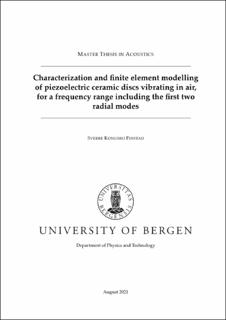Characterization and finite element modelling of piezoelectric ceramic discs vibrating in air, for a frequency range including the first two radial modes.
Master thesis
Permanent lenke
https://hdl.handle.net/11250/2778972Utgivelsesdato
2021-08-13Metadata
Vis full innførselSamlinger
- Master theses [159]
Sammendrag
The objectives of this work is to measure and characterize the electrical and acoustical behaviours of a piezoelectric ceramic disk of type Pz27, across a frequency spectrum covering the first two radial modes, and to compare these measurements to FEM simulations. The electrical parameters such as admittance, conductance and susceptance of a sample of elements are measured, in a frequency range from 1 kHz to 300 kHz, encompassing the two first radial modes of the elements. The acoustic chracteristics of one of these elements will also be studied and compared to simulations. Here, parameters such as the source sensitivity, directivity, on axis pressure, and sound pressure field will be measured using a microphone as a receiver. Finite element modelling (FEM) simulations of the piezoelectric ceramic discs radiating in air are preformed. This data is compared to the measurements of the element admittance, directivity beam pattern, transmitter sensitivity, on-axis pressure, and sound field. The FEM software used is FEMP 6.1. Methods of converting signal pulses to sound pressure values are examined in this work. This includes methods for finding peak to peak voltage of the received signals, as well as corrections for signal losses, either due to losses in air, or losses due to impedances in wires and instruments used. A method for calculating microphone receiver sensitivity is also examined, based on the use of a pistonphone calibration and correction data.
